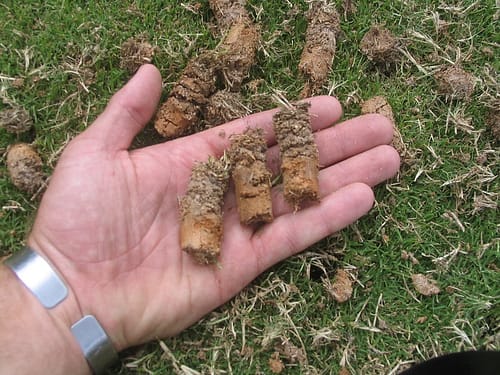This post may contain affiliate links. As an Amazon Associate we earn from qualifying purchases.
Summer lawn care should begin before summer. Read on to learn how to get your summer lawn ready for the heat.
Media headlines are warning us:
- “Early forecast says summer 2024 is set to be unusually hot across most of USA” (usatoday.com)
- “Summer 2024 Temperature Outlook: It Could Be One Of The Nation’s Hottest” (weather.com)
- “Will it be a hot summer? Odds are yes for all but 2 states, NOAA says” (thehill.com)
Those two states? The Dakotas, both North and South.
If you live anywhere else, it’s time to think about getting your lawn in top shape and ready to take on the heat!
Supplies you’ll need to get your grass ready for summer
- Dethatching rake
- Core aerator
- Landscaping flags
- Slow-release, low-nitrogen fertilizer
- Lawn mower
- Grub control
- Fertilizer
 Step 1: Dethatch your lawn
Step 1: Dethatch your lawn
What is thatch?
That is the layer of soil and decayed grass that builds up directly below the grass blades. It can grow into a thick mat that will block the sunlight, air and oxygen from the lawn’s roots.
If you have a lawn and don’t have a dethatching rake, go get one. Then, watch this brilliant YouTube video that walks you through the process.
Detaching, by the way, is just the first step to get the grass ready for summer.

Step 2: Now the lawn needs to be aerated
Now that you have the thatch out of the way, it’s time to turbo charge the lawn’s ability to receive fertilizer, air and water.
If you’re growing a cool season grass, such as Kentucky bluegrass or fine fescue, it’s most likely dormant now, so save aeration for the fall.
Warm season grass growers need to get started on aerating the lawn right now, in spring.
There are several ways to accomplish this. I have a rather small lawn so I bought a manual lawn aerator (this one, at Amazon.com) and it has proven to be more than sufficient.
Larger lawns require a larger core aerator and you can purchase those online as well.
Better yet, they’re available to rent at Home Depot and select Lowe’s stores.
Before you head off into that wild green yonder, though, you have one more job to do.
Mark your sprinklers with landscaping flags if you’ll be using a tow behind or self-propelled aerator.
Step 3: Lousy at watering?
Start a new routine and then stick to it. “Most grasses will need about one inch of irrigation each week during their peak growing season,” the folks at Scott’s claim.
How do you know when it’s received that inch of water? As a new lawn owner, years ago, I wondered the same thing. Someone advised me to water the lawn and time how long I watered it.
Then, I use a screwdriver as a probe, randomly sticking it into the lawn to see if it came up wet to an inch down. If so, I would use that length of time to water. If not, water some more, and don’t forget to time how long you left the water on each time.
Those pros at Scott’s also remind us that a single, slow, deep watering is much better than running outside and waving a hose over it now and again.
Remember the roots: they will be the determining factor in how your lawn stands up to summer sun and heat.
Water more often in the heat of summer but do so in the early morning. Watering at night can cause the humidity to build up which is attractive to fungal spores.
 Step 4: Mow, mow, mow your summer lawn
Step 4: Mow, mow, mow your summer lawn
Frequent springtime mowing helps strengthen roots, making your grass stronger. But before you run out to the shed to kick-start the mower, ensure that the blades are sharp.
Have you ever used a pair of pruners that needed sharpening? If so, you know that they typically end up crushing the stem you’re attempting to remove. With grass, you’ll end up with shredded grass which will most likely turn brown.
It’s the same with dull mower blades. For a clean cut, sharpen those bad boys. Check out this handy walk-through on how to sharpen mower blades at realhomes.com.
Then, raise the height of the blades as we get closer to summer. The idea here is to allow the grass to get a bit taller to help shade the soil it’s growing in.
Finally, leave the grass clippings on the lawn to give it an extra boost of “fertilizer.”
Step 5: Treat the lawn for pests
Lawns create the perfect environment for certain pests. Probably the most despised is the lawn grub. Lawn grub treatment can be challenging. Be on the lookout for:
- Army worms
- European chafers (use beneficial nematodes, see below)
- Japanese beetles
- Sod webworms
The list of all lawn pests is much longer than mine, but you get the picture – lawns aren’t just attractive to people. And these seem to be the most common.
So, how to manage these pests? Let’s dive into that.

Army worms
These guys are monsters. Not only will they destroy any plant in their paths, but they love grass. The moth they come from (Spodoptera frugiperda) can have a wingspan of more than 1.5 inches, she flies around at night and lays a huge number of eggs which, when hatched, release big ugly babies.
Although army worms are worse in the southeastern U.S. they appear in all states east of the Rockies, just not in as large a volume.
Their life is short, luckily. They live 30 days during the summer, 60 in spring and fall and 80 to 90 in winter. During this time, however, “… total egg production per female averages about 1500 with a maximum of over 2000,” according to entomologists with the University of Florida IFAS Extension.
Get after these pests with a product that contains Bacillus thurengiensis kurstaki, sometimes labeled at Btk. This particular strain (kurstaki) goes after caterpillars specifically.
Bt, by the way, is a naturally occurring bacteria in soil and non-toxic for pets and people.
We like BONIDE® Thuricide, which contains Bacillus thuringiensis v. kurstaki. Pick it up at Amazon.com (where else, right?)

European chafers
“The European chafer [Rhizotrogus majalis] is a very serious grub pest of turf and can cause more turf damage than the Japanese beetle,” warns the experts at the Minnesota Department of Agriculture.
It’s not the adult beetles that cause the damage; apparently they don’t eat (wish I could be so lucky!). It’s the youngin’s that do all the damage by feasting on the grass’ roots.
Adults overwinter in the soil and emerge, depending on what part of the country you’re in and the temperature, between the middle of June and early July.
Eggs are laid a whopping four inches into the soil and they hatch in August. This depth is what protects them from the usual remedies for lawn pests.
Symptoms of an infestation include large brown spots in the lawn. If not remedied, the chafer larvae may kill the grass.
The best control to date is a beneficial nematode, Heterorhabditis bacteriophora, applied to the soil. Beneficial nematodes are “… microscopic, non-segmented roundworms that occur naturally in soil throughout the world,” according to the pros at Arbico Organics.
“Inside the nematode’s gut is the real weapon — beneficial bacteria that when released inside an insect kill it within 24 to 48 hours,” they continue.
These are harmless to people and pets by the way. And, it also controls ants and Japanese beetle infestations.
When shopping for these, keep in mind that there are various species. You want the Heterorhabditis bacteriophora, often abbreviated as Hb on package labeling. You can find them for sale on Amazon.com.

Japanese beetle grubs
Scientifically known as Popillia japonica Newman, the Japanese beetle is well-known for it’s varied diet. It seems as if there isn’t a plant on earth this guy (or his kids) won’t eat.
It’s the kids, by the way, that munch on the roots of lawn grasses. Apply your chosen control method from July until late September.
What to use? Beneficial nematodes work best for Japanese beetle grubs in the lawn. Look for a product that contains Steinernema riobrave. Arbico Organics carries them online.

Sod webworms
Although there are more than 20 species of sod webworms that infest turf grass, the most common is in Crambus genus.
The larvae spend the winter in the thatch or in the soil just beneath it. When the weather warms, they do the transformation thing into moths. This typically happens in late spring or early summer, depending on where you live.
Then, in June, the egg-laying begins. The larvae stick around during June and July, at which time they commence to feast on your grass.
Symptoms of a sod webworm infestation include patches of grass that appear chewed off at ground level. “Fresh clippings and green fecal pellets are also usually present,” according to the experts at the University of Nebraska-Lincoln, Department of Entomology.
Here’s a cool trick to determine without a doubt that it’s sod webworms destroying your lawn.
- Mix 1/4 cup of household detergent with 2 gallons of water.
- Apply one gallon of this solution to an area where you suspect the pests.
- Wait about 10 minutes for the worms to come to the surface. Apparently, the solution irritates them and they come up to escape it.
- Count the webworms. “… if 15 or more webworm larvae are present per square yard in reasonably healthy turf, an insecticide application may be justified.” (University of Nebraska)
The best remedy for sod webworm infestations is a biological insecticide that contains Bacillus thurengiensis v. kurstaki (Btk). We introduced you to this earlier when we discussed armyworms. Bonide’s Thuricide is our go-to product and you an get it on Amazon.com.
 Step 6: Yes, the summer lawn needs fertilizer
Step 6: Yes, the summer lawn needs fertilizer
“Feeding in the early summer helps strengthen the lawn so it can better withstand the heat and drought conditions that summer is famous for,” say the experts at Scott’s.
Some experts say that fertilizer shouldn’t be applied when temperatures exceed 85 degrees Fahrenheit, while others say 90 degrees is the cutoff. I always go with the lower temperature because fertilizer and heat can fry the grass.
Make the application in mid- to late-May, and again in late August or early September.
Use a slow release fertilizer, such as Milorganite, available at TractorSupply.com. It is a slow-release lawn fertilizer that I highly recommend.
Sure, this process looks overwhelming in writing, but take it one step at a time and you will be so glad you did it.
The more you prepare your lawn, the better it will handle whatever summer throws at it.
Want to save on your water bill? Check out this post about How to Collect Rain Water
Mention of a fertilizer or pesticide, or use of a pesticide or fertilizer label, is for educational purposes only. Always follow the product’s label directions attached to the container you are using. Be sure that the plant you wish to treat is listed on the label of the pesticide you intend to use. If growing edibles, check the label for the number of days between pesticide application and when you can re-enter the area and/or harvest your crop.






